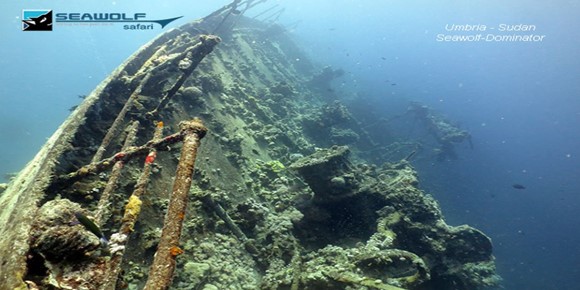Overview
To supply Italian troops in Aden, the "Umbria" is loaded with various war materials in Genoa, Livorno and Naples at the end of May 1940. The ship, which was converted from a passenger steamer to a material and troop carrier in 1935, had already been used for such voyages before
Description
Over 360,000 bombs and 60 boxes of fire bombs and other explosives are stowed in the 5 holds. Furthermore cars, airplane parts as well as cement bags and other building materials.
The Umbria's route takes it via Messina in Sicily to Port Said, from where it is to sail through the Suez Canal and the Red Sea to East Africa.
After entering Port Said on June 3, she bunkers another 1000 tons of coal and 130 tons of water. Here 23 British Navy soldiers as well as 2 pilots board the ship. In view of the imminent entry into the war between Italy and England, the Channel passage is deliberately delayed. So the "Umbria" leaves Suez with her explosive cargo only 3 days later.
From now on, the gunboat "Grimsby" pursues her. It stops the freighter at Port Sudan, claiming that she is in British territorial waters. As a result, the "Umbria" drops anchor at Wingate Reef on June 9.
Under the pretext of searching the ship for smuggled goods, 22 soldiers from the New Zealand cruiser "Leander" are brought on board under the command of Lieutenant Steves. They immediately occupy the strategically important points and begin a time-consuming search.
In the afternoon, Captain Muiesan learns over the radio in his cabin that Italy will declare a state of war at 7:00 p.m. and that the first acts of war are to be expected from 0:00 a.m. the following day.
Muiesan realizes that he cannot lose any more time, so that the strategically important cargo does not fall into enemy hands. Together with first officer Radolfo Zarli and flight engineer Carlo Costa, he plans the sinking.
They have difficulty evacuating the crew without attracting attention.
Finally, Muiesan suggests to Lieutenant Steves to carry out a rescue exercise, which the Lieutenant approves in the hope of being able to detain the "Umbria" even further. While the Italians begin the exercise, news reaches Steves on the bridge of severe water ingress throughout the ship. After a few minutes and with the increasing list of the ship, he realizes that he can no longer prevent the sinking.
On board the "Gimsby", Muiesan informs him of Italy's entry into the war and that he had given the order to sink the ship himself.
He then goes with his crew to India as prisoners of war before the outbreak of war.
Hotspots
- Nine years after her sinking, the "Umbria" arouses the interest of Hans Hass, then 30 years old. His contacts with the governor of Port Sudan finally enabled him to dive on the "Umbria".
- His photo and film material contributed considerably to the myth of the wreck.
- In the meantime, the "Umbria" is one of the most famous wrecks in the Red Sea.

 ENGLISH
ENGLISH
 РУССКИЙ
РУССКИЙ
 DEUTSCH
DEUTSCH

